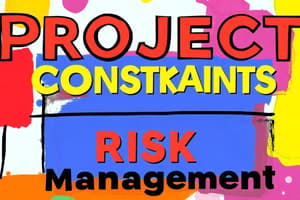Podcast
Questions and Answers
Which characteristic distinguishes a project from ongoing business activities?
Which characteristic distinguishes a project from ongoing business activities?
- Repetitive tasks with consistent outcomes
- Temporary endeavor with a defined beginning and end (correct)
- Focus on maintaining existing processes
- Continuous resource allocation
Which of the following is NOT considered a primary constraint in project management?
Which of the following is NOT considered a primary constraint in project management?
- Team Morale (correct)
- Cost
- Scope
- Time
In project management, what does the term 'triple constraint' refer to?
In project management, what does the term 'triple constraint' refer to?
- The three types of project risks
- The three phases of project management
- The interconnected constraints of time, scope, and cost (correct)
- The three main stakeholders in a project
Which of the following best describes Project Management?
Which of the following best describes Project Management?
What is the primary purpose of the 'Need Identification' phase in software project management?
What is the primary purpose of the 'Need Identification' phase in software project management?
Which component of a Vision and Scope document details the boundaries of the project?
Which component of a Vision and Scope document details the boundaries of the project?
What is the MAIN purpose of creating a project plan?
What is the MAIN purpose of creating a project plan?
Which phase of the project management lifecycle involves defining project objectives and feasibility?
Which phase of the project management lifecycle involves defining project objectives and feasibility?
In which phase of the project management lifecycle are detailed plans developed for time, cost, and resources?
In which phase of the project management lifecycle are detailed plans developed for time, cost, and resources?
What is the primary goal of the Project Initiation phase?
What is the primary goal of the Project Initiation phase?
Which document is a key deliverable of the Initiation phase?
Which document is a key deliverable of the Initiation phase?
What is the main purpose of a Work Breakdown Structure (WBS) in the Planning phase?
What is the main purpose of a Work Breakdown Structure (WBS) in the Planning phase?
What is the purpose of creating a risk mitigation plan during the Planning phase?
What is the purpose of creating a risk mitigation plan during the Planning phase?
In which project phase does the project team carry out the activities identified in the project plan?
In which project phase does the project team carry out the activities identified in the project plan?
What is the primary focus of the Monitoring & Control phase of project management?
What is the primary focus of the Monitoring & Control phase of project management?
What is the goal of Project Closure?
What is the goal of Project Closure?
Which activity is typically performed during the Project Closure phase?
Which activity is typically performed during the Project Closure phase?
Which of the following is a primary objective of Software Project Management (SPM)?
Which of the following is a primary objective of Software Project Management (SPM)?
What is the purpose of software project planning?
What is the purpose of software project planning?
What does Software Project Estimation involve?
What does Software Project Estimation involve?
Flashcards
What is a Project?
What is a Project?
A one-time activity with a series of tasks that produces a specific outcome to achieve organizational goals.
Project Characteristics
Project Characteristics
Projects are unique, temporary, and operate within constraints.
Primary Project constraints?
Primary Project constraints?
Time, cost, scope and quality
What is Project Management?
What is Project Management?
Signup and view all the flashcards
Key components of Software Project Management (SPM)
Key components of Software Project Management (SPM)
Signup and view all the flashcards
Purpose of Need Identification
Purpose of Need Identification
Signup and view all the flashcards
Vision (in project scope)
Vision (in project scope)
Signup and view all the flashcards
Scope (in project scope)
Scope (in project scope)
Signup and view all the flashcards
Project Management Life Cycle
Project Management Life Cycle
Signup and view all the flashcards
Project Initiation Phase
Project Initiation Phase
Signup and view all the flashcards
Project Planning Phase
Project Planning Phase
Signup and view all the flashcards
Project Execution Phase
Project Execution Phase
Signup and view all the flashcards
Project Monitoring Phase
Project Monitoring Phase
Signup and view all the flashcards
Project Closure Phase
Project Closure Phase
Signup and view all the flashcards
Project Charter
Project Charter
Signup and view all the flashcards
Project Planning Purpose
Project Planning Purpose
Signup and view all the flashcards
Project Plan
Project Plan
Signup and view all the flashcards
Software Project Estimation
Software Project Estimation
Signup and view all the flashcards
Basic COCOMO Model
Basic COCOMO Model
Signup and view all the flashcards
Analogy-Based Estimation
Analogy-Based Estimation
Signup and view all the flashcards
Study Notes
- Any effort to produce tangible or intangible results is a project.
- A project is a one-time activity with tasks producing a specific outcome for organizational goals.
- Projects break down into objectives with steps to stay on track and complete as planned.
Project Characteristics
- Each project is unique, creating something new or improving something existing.
- Projects are temporary with a definite beginning and end.
- Projects operate within time, budget, scope, quality, resources, and risk constraints.
- Completion occurs when project goals are achieved, but projects can be canceled if they're no longer viable.
Primary Project Constraints
- Time is the schedule for project completion.
- Cost is the budget for meeting objectives and completing on time.
- Scope is the project's specific deliverables.
- Quality is the standard of the project's outcome.
- Projects must be managed within time, scope, and quality constraints, known as the "triple constraints."
- Scope, cost, and schedule are imperative for project processes which define boundaries for project execution.
- Success or failure depends on meeting constraints like deadlines, scope, and budget within acceptable limits.
- Constraints are interconnected; changing one can affect others.
Project Management
- Project Management applies knowledge, skills, processes, methods, and tools to meet specific project requirements within a set budget and timeframe.
- It includes principles to lead a project from start to finish
- It involves identifying needs, planning with achievable objectives, and executing the plan until goals are achieved.
- Project goals and objectives are a concise way to communicate goals and evaluate project success.
- Each project should have a plan from start to finish, describing how things will be accomplished and completed.
Fundamentals of Software Project Management (SPM)
- SPM is managing software projects to meet objectives under scope, time, cost, and quality constraints.
Key Components of SPM
- Planning involves schedules, budgets, and resource allocations.
- Execution involves implementing the project plan and managing the team.
- Monitoring involves tracking progress and addressing deviations.
- Closure involves delivering the product and documenting lessons learned.
Importance of SPM
- SPM ensures efficient resource use, minimizes risks, and aligns project deliverables with business goals.
Need Identification
- The purpose is to understand the problem or opportunity the software addresses.
- Steps include:
- Analyzing existing challenges or gaps.
- Collecting stakeholder feedback.
- Defining high-level requirements.
- Example: An online food delivery system addresses manual food ordering.
Vision and Scope Document
- Vision describes the project's long-term goal and purpose.
- Example: An app simplifies food delivery for urban users.
- Scope details the project's boundaries.
- In-Scope: Features to be developed, like online ordering and payment gateway.
- Out-of-Scope: Exclusions, like in-house delivery personnel.
- Importance: It ensures clarity and alignment among stakeholders.
Project Management Life Cycle Overview
- Project management is essential for all businesses, gaining popularity and importance across industries.
- Organizations strive for excellence to achieve a global presence.
- Project management is vital in construction, engineering, IT, manufacturing, banking, finance, healthcare, pharma, NGOs, nonprofits, and government.
- Managing projects effectively is critical due to mission-critical initiatives like Digital Transformation and KYC.
- Projects have a start and end, beginning with defining objectives followed by a plan to meet those objectives.
- A clear understanding of the project management life cycle is essential for successful project execution.
- It describes the high-level process of delivering a project and the steps involved.
- It can be structured, timely, and methodical for effective project execution.
Phases of the Project Management Lifecycle
- Initiation: Define project objectives and feasibility.
- Planning: Develop detailed plans for time, cost, and resources.
- Execution: Implement the plan and manage team activities.
- Monitoring: Track progress and handle deviations.
- Closure: Finalize and deliver the project, then evaluate outcomes.
- Example of building an e-learning app involves:
- Initiation: Identify the target audience and goals.
- Planning: Schedule content creation and development timelines.
- Execution: Develop the app and test it.
- Monitoring: Check progress regularly and fix issues.
- Closure: Launch the app and gather user feedback.
- The project management lifecycle is divided into 5 phases: initiation, planning, execution, monitoring & control, and closure.
- Projects follow 5 phases from identification to completion, irrespective of execution methodology, either traditional "Waterfall" or Agile.
1. Project Initiation
- Define the project at a broad level.
- Identify stakeholders, goals, objectives, deliverables, resources, and money needed.
- High-level determination is made whether the project is feasible.
- The key deliverable is the Project Charter.
Key Project Management Steps in the Initiation Phase
- Conduct a feasibility study to identify the primary problem the project solves and whether the project can deliver a solution.
- Create a business case and define the project at a high level.
- Create a Project Charter or project initiation document outlining vision, objectives, and goals.
- Identify the high-level project scope and define the product or service to deliver.
- Identify key project stakeholders.
- Assemble the project team and establish a project office once the project gets a go-ahead.
- Business case, feasibility study, and a Project Charter determine if the project is approved.
- Project initiation meetings finalize the project.
2. Project Planning
- This phase begins after the project receives a green light in the Initiation phase.
- The Project Planning phase is critical and requires diligence:
- Involves defining the work to be done and figuring out how to accomplish it.
- The level of detail will depend on the size of the project.
- The project manager begins setting goals with a project plan.
- A well-crafted plan outlines a schedule, communication plan, and risk management approach.
- The project manager defines the project scope and project management plan involving cost, quality, resources and project timeline.
- Scope is defined using a scope statement and Work Breakdown Structure (WBS).
- A crucial activity is the effort and resource estimation for the project where rough order of magnitude (ROM) estimates are produced.
Key Project Management Steps in the Planning Phase
- Create a Statement of Work document to flesh out the details of project deliverables.
- Develop a Work Breakdown Structure.
- Create a project plan, assign team members (and other resources) to tasks and build a timeline.
- Identify the Project Team roles and other needed resources.
- Identify potential risks and develop a strategy to minimize them.
- Incorporate an effective change management plan
- Create a communication plan to schedule interactions with relevant stakeholders.
3. Project Execution
- Carrying out the activities identified in the project plan.
- This is the action and practical phase where planning is turned into action.
- Specific people and other resources are assigned to identified tasks.
- The work is carried out in a specific order to complete all of the work.
- The key outcome of the Execution phase are the defined deliverables that are produced.
- The project manager establishes workflow while maintaining collaboration between the team and various stakeholders.
Key Project Management Steps in the Execution Phase
- Identify and assign the project team; assign the team and other resources to the project tasks; begin work.
- Provide necessary guidance to the team on how tasks should be completed.
- Monitor team progress.
- Communicate with the stakeholders regularly to ensure the project deliverables are acceptable.
4. Project Monitoring & Control
- The project monitoring and control phase runs parallel with execution.
- This involves keeping the objectives and deliverables on track by reporting on performance.
- Helps to track any deviations from the scheduled budget, timeline, and quality standards.
- Necessary changes should be implemented with approval from stakeholders.
- Continuously monitoring for any potential risks and issues which could impact performance
- Taking the necessary steps to mitigate proactively.
Key Project Management Steps Involved in the Monitoring and Control Phase
- Tracking the progress of various project tasks
- Measure budget, timeline and quality performance of the project
- Conduct user reviews and collect feedback and carry out any corrective actions needed.
- Track all the changes to the project scope, either through the team or the stakeholders in a report to the goals of the project.
- Monitor the overall performance of the project, the plan changes and making sure the stakeholders and team are on the same level with the project status and expected outcomes.
5. Project Closure
- Indicates the very end of deliverables of the project management life cycle.
- Completion of the delivery is indicated and finalized by the stakeholders.
- Aspects can only be carried out once the closure is formally approved.
- The project manager conduct post-project review meetings or a retrospective:
- To review any challenges and lessons learned.
- Once activities are done and completed the team members will be released to other projects.
Project Management steps involved in the closing phase
- Conduct an "End of Project” Review or Retrospective and to analyze project performance and a formal analysis of successes and failures.
- Document the reports and closure and provide them to all the stakeholders.
- Accounts used for the budget and release any remaining resources for further projects.
Objectives of SPM
- Deliver the project inside the budget
- Meeting the expectations and the quality of the product
- Optimize the resources and reduce any risks
- Enhance the team collaboration and the communication
Software Project Management (SPM) Framework
- A systematic structure which will guide the management of software projects.
Key Components of the SPM
- Define all goals.
- Identify the stakeholders
- Perform feasibility studies
- Establish the timelines and the scope
- Teams will implement the plans
- Tracking all progress
- Deliver projects and review outcomes for quality.
Software Project Planning
- The process of completing a plan for a software project.
- Defining all the steps within the set budget, time and scope.
Importance of Software Project Planning
- Helps to find better allocation and resource effectiveness.
Definition of Planning Objectives
- Specific goals which aim to accomplish.
- The project is ensured to have resources in the budget
- Mitigation and risk planning
- Clarity from the team roles and expectations.
Project Plan
- A detailed document which will be executed, monitored and controlled.
Key Elements
- Scope defines what will and will not be in a project.
- Timeline, Specific deadlines and milestones
- All resources are allocated effectively
- Managing potential challenges
Project Plan (Example)
- Integrating the payment system
- Creating a friendly interface for users
Types of Projects
- Master Plan
- An overview of aspects in the project.
- Technical, resource, and financial plans.
- Operational Plan
- Focuses on the testing, the debug and day to day activity.
- Schedules will be testing and coding in a mobile project.
- Resource Plan
- Details, the members, tools and the architecture of the tools.
- Financial Plan
- Cost management and budgeting.
- Tools and developing budgets.
- Risk Management Plan
- Outlines the Mitigation and identifying the risks that are possible.
- Regularly backing up to address system flaws.
Structures of A Software Project Management Plan
- Introduction
- Project objectives as a summary
- Scope
- A description of the project's accomplishments
- Project Organization
- Roles and responsibilities of the team members
- Risk Management
- Identified risks and what strategies address them
Project Schedule
- Deadlines and timelines and setting Milestones
- Example is with phases, where there are requirements for the gathering
- Budget
- Costs and personnel
- Example that the budget is a total of 500 dollars which will include about 5000 tests.
- Quality Assurance
- To ensure the deliverables meet.
- High scores for use satisfaction.
Software Project Estimation
- Describing effort to successfully complete
- Involves time, cost and resources
- Realistic planning to set the deadlines.
- Helps the allocation, the tools and infrastructure
- Managing risk by identifying the challenges.
Factors Influence Estimation
- Project Size has features that increase effort.
- Project complexity with technologies with brand new technologies
- Team skills can reduce and improve the development effort.
- Ambiguity can increase the error.
Estimation Methods
- Algorithmic to non-algorithmic approaches.
- The COCOMO, constructive construct model estimates the budget and complexity of projects.
- A detailed part with the costing drivers with the database.size
Function Point Analysis
- Calculates the function outputs and files
- Weights will be based on the complexity
- Examples the the database system.
Heuristic Models
- Models with the expert judgement and data analysis
- Analogy Estimations
- Completed data can be set to determine the project
- Bottom up Estimations are a process that breaks down project tasks separately.
- Top down estimation breaks it down smaller tasks and divides it.
Studying That Suits You
Use AI to generate personalized quizzes and flashcards to suit your learning preferences.




